Broadly Distributed Bloom Waters This Spring
Mahogany Tide conditions are being reported from the lower Potomac River, lower Patuxent River, into the Main Bay and on the Eastern Shore in the Choptank River. Anecdotal reports have likely observations along the western shore from North Beach, Carrs Creek in Deale and as far north as Spa Creek in Annapolis.
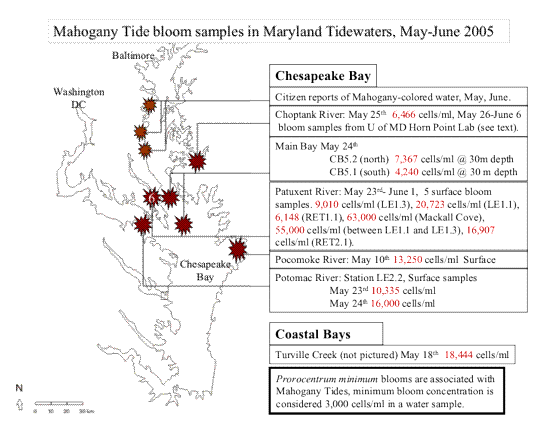
Springtime Mahogany Tides caused by Prorocentrum minimum were absent in April and first detected during the second week of May for Maryland tidal waters. A bloom level is considered 3000 cells per milliliter for this Mahogany Tide organism. Maryland Department of Natural Resources has recorded bloom concentrations first in Chesapeake Bay (May 10th Pocomoke River 13,250 cells/ml), and then in the Coastal Bays (May 18th, Turville Creek 18,444 cells/ml). During the second half of May, bloom samples were detected by Morgan State University Estuarine Research Center sampling in the Potomac and Patuxent Rivers. Citizen reports of the brown waters have been mostly along the western shore but University of Maryland Horn Point Lab staff have observed bloom waters in the lower Choptank River below the Route 50 bridge since May 31. The pattern of observations is suggesting the bloom is moving north as it follows the salt wedge and warming temperatures up the Bay towards Baltimore.
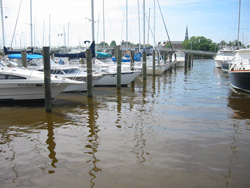 A follow-up investigation to the reports on Spa Creek during the week of June 6 found mahogany to brown water from shore to shore between Eastport and Annapolis. A sample collected by Maryland DNR from Spa Creek on June 7th had 123,490 cells/ml of Prorocentrum minimum, the highest concentrations encountered so far this year. Characteristics of the distribution and magnitude of this bloom are approaching conditions comparable to the year 2000 Mahogany Tide on Chesapeake Bay. A follow-up investigation to the reports on Spa Creek during the week of June 6 found mahogany to brown water from shore to shore between Eastport and Annapolis. A sample collected by Maryland DNR from Spa Creek on June 7th had 123,490 cells/ml of Prorocentrum minimum, the highest concentrations encountered so far this year. Characteristics of the distribution and magnitude of this bloom are approaching conditions comparable to the year 2000 Mahogany Tide on Chesapeake Bay.
Choptank River: Bloom Results from Dr. Diane Stoecker, Dr. Patricia Glibert and Staff at the University of MD Horn Point Lab
Bloom samples of Mahogany Tide have been collected since May 26th on the Choptank River downstream of the Route 50 bridge at the Horn Point Laboratory pier. Water samples were collected on May 26, 31, June 1, 2 and 6 all containing elevated concentrations of the dinoflagellate Prorocentrum minimum. On June 1, the average of 3 samples peaked at 72,505 cells/ml.
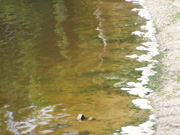 |
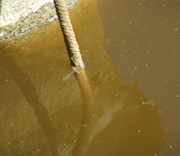 |
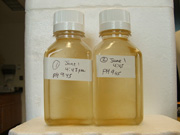 |
| Photos courtesy of D. Stoecker, U of MD - HPL |
On June 6, 14 stations were sampled in the vicinity of the Horn Point Laboratory across to Holmes Creek and upstream to just above the Rt. 50 Bridge area of Cambridge. Thirteen of 14 samples (93%) had values greater than 3000 cells/ml. The average concentration was 29,491 cells/ml with a maximum of 55,717 cells/ml.
No Fish Kills Related to the Events Thus Far
No fish kills or other living resource health events have been associated with those bloom locations so far this season. Water temperatures are warming across the region and remain average for the season at the surface of the Chesapeake Bay as we move into summer. Continuous monitoring stations across the region continue to show nearshore dissolved oxygen levels are above 5 mg O2/L, favorable for Bay life. However, dissolved oxygen conditions of the lower waters of the Chesapeake Bay are below average in many areas for the year, particularly in the middle of the Bay; tributary conditions are more variable (Visit our Eyes on the Bay website for water quality conditions across Marylands tidal waters). In 2000, the persistence of a Mahogany Tide was linked with reduced acreage of submerged aquatic vegetation in the middle of the Bay as a result of poor water clarity due to bloom waters limiting light to the plants.
General Water Quality
Runoff from winter and spring rains have increased delivery of sediment to the Chesapeake Bay and tributaries causing lower water clarity and moving lower salinity water further down the Bay (See Eyes on the Bay Monitoring Story from April 2005 "Heavy Rains and Run-off Lower Salinities and Restrict Water Clarity in the Chesapeake Bay"). Colder than average temperatures have been typical of Chesapeake and Coastal Bays region this spring. Associated with the rains has been cloudy and windy weather, often unfavorable for the development of bloom conditions of Mahogany Tide. In 2000, rains were common in early spring before a hot, sunny period of about 10 days rapidly warmed the Bay waters and was associated with the most widespread Mahogany Tide observed in recent years. The warm, sunny weather this week may promote an increasing intensity of this years bloom.
For up to date information on all of Maryland's harmful algal blooms and water quality, please visit Eyes on the Bay
|


 A follow-up investigation to the reports on Spa Creek during the week of June 6 found mahogany to brown water from shore to shore between Eastport and Annapolis. A sample collected by Maryland DNR from Spa Creek on June 7th had 123,490 cells/ml of Prorocentrum minimum, the highest concentrations encountered so far this year. Characteristics of the distribution and magnitude of this bloom are approaching conditions comparable to the
A follow-up investigation to the reports on Spa Creek during the week of June 6 found mahogany to brown water from shore to shore between Eastport and Annapolis. A sample collected by Maryland DNR from Spa Creek on June 7th had 123,490 cells/ml of Prorocentrum minimum, the highest concentrations encountered so far this year. Characteristics of the distribution and magnitude of this bloom are approaching conditions comparable to the 

